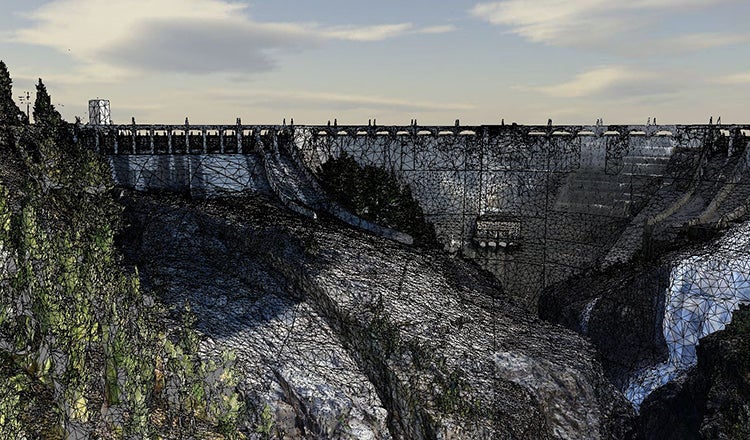
Digital Twin of Diablo Dam Comes to Life
Dynamic 3D Model Predicts Asset Management Needs
It’s exciting when an idea takes flight. And it’s truly inspiring when that idea becomes a reality. For Seattle City Light, a hydropower technology leader, we recently developed a digital twin model of the utility’s Diablo Dam.
Advancing the Model
As part of our role as owner’s engineer, the idea sparked when we worked with SCL to complement its traditional rope-access inspections with an unmanned aerial system (e.g., drone) flight. We captured high-resolution imagery of Diablo Dam efficiently and safely. The images detailed the spillways, rock abutments and arch dam.
During a 6-hour flight, we collected more than 82 million data points (x, y and z coordinates) to document the current condition of concrete structures and provide a baseline for future observations. This data capture and the development of the subsequent digital twin model marked a key milestone in serving SCL and the community for years to come.
Defining 'Digital Twin'
A digital twin sounds futuristic and, in many ways, it is. Put simply, it means we’re creating a digital version of something physical and updating the model as conditions change. The technology allows us to completely merge our architecture, engineering and construction disciplines across the life cycle of infrastructure and facilities.
One of the core components of Diablo Dam’s digital twin is a reality mesh — a survey-grade 3D representation that’s made lifelike with high-res photography. For this project, the drone captured images with a roughly 60% overlap, and we then stitched them together through a process called aerotriangulation. Tying that data to the ground-control survey and engineering drawings, we achieved 2-centimeter accuracy in the plans. And we applied artificial intelligence and machine learning algorithms to automatically identify areas of concrete that contained certain anomalies — differentiating between cracks and spalls. We then created the virtual digital twin of the dam to serve as the baseline of the structure.

Improving the ‘Living, Breathing’ Model Over Time
Diablo Dam’s digital twin gives SCL another reference point to understand its asset, and provides a new way to maintain awareness and improve and visualize the surveillance and monitoring of the dam. By having a digital twin of the asset, it can save countless hours.
Future uses of the model may include additional hydraulic engineering, uplift analysis, and change and anomaly detection. We “feed” the model with data from other acquisition technologies (e.g., piezometers, seepage and leakage detectors, and ground-penetrating radar). These data points integrate into the digital twin to develop an even more complete picture.
The effectiveness of the model increases exponentially with time. With its predictive analytics capability, the professionals at SCL will be able to compare data from a given year versus the next one. When they see what changed, possibly a slight shift in the structure, they can assume (with no anomalies or earthquake-type events) that the structure will continue to shift at a similar rate over time. The information will help SCL prioritize places to repair.
What’s inspiring to me is that the digital twin provides more access to high-fidelity imagery and data. The dam is safer, and the ability to get data is safe and efficient. Standing on its own or augmenting rope access inspections, drone data is valuable and cost-effective. Rope access inspections provide the benefit of “arm’s length” observation and “hands-on” exploration of features by trained individuals that cannot be fully replicated by drone data collection. However, the data and mapping provided by the drone extends the range, accuracy and repeatability of the inspection process at a lower cost.
The work plays a significant part in reinforcing Seattle’s overall power supply.
Applying Additional Technologies to Create a Digital Twin
Drone technology is just one entry point to building a dynamic 3D model. Lidar, which measures distances by illuminating targets with laser light, proves very effective in acquiring data. We’ll take a closer look at this technology in future communications.




